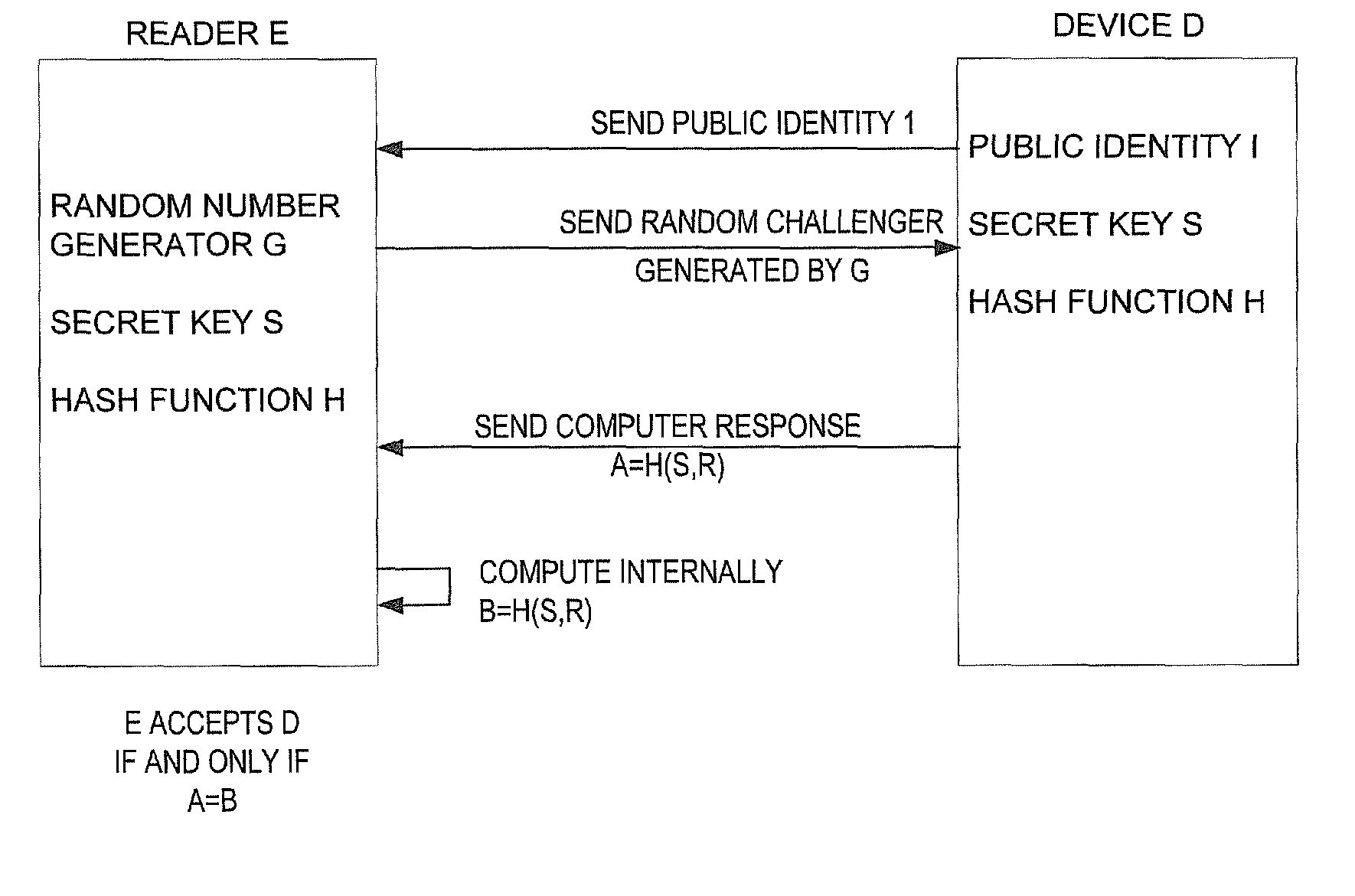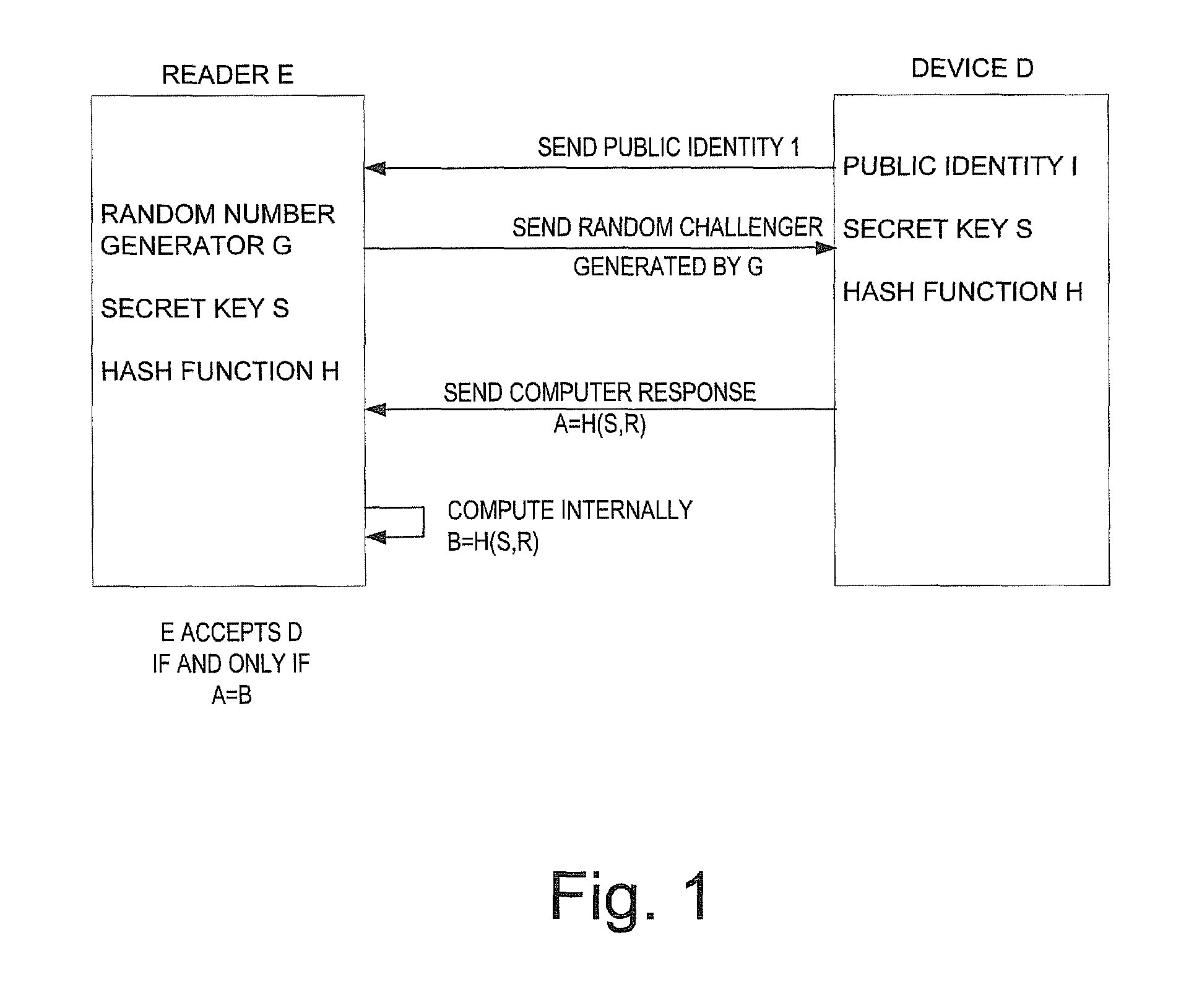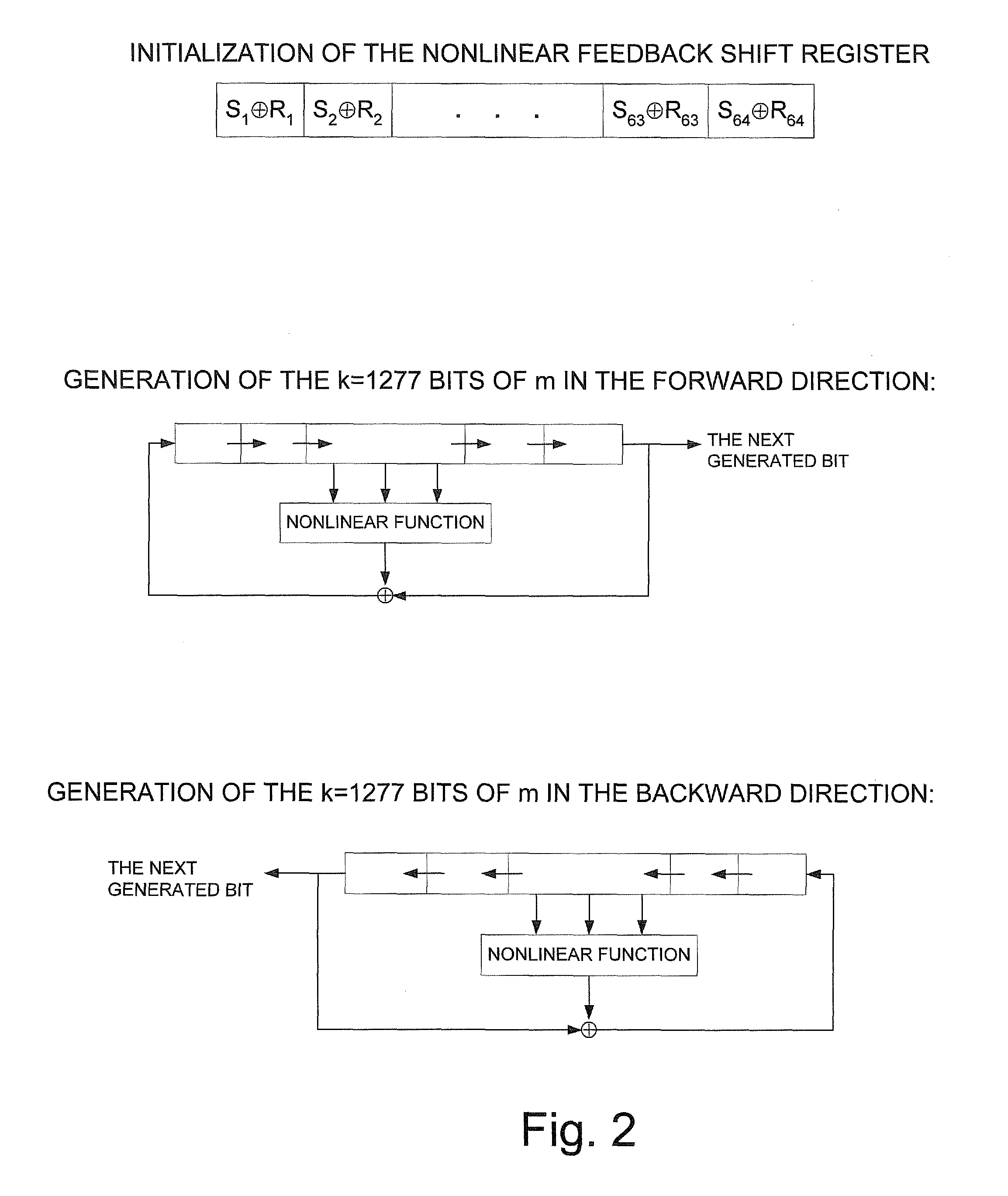[0021]The present invention for a method and apparatus for implementing one-way hash functions on highly constrained devices, and more particularly to a method and apparatus that utilizes a simple one way hash function with
provable security properties that can be implemented on highly constrained devices, such as RFID tags, is accomplished by a novel modification of the Rabin
encryption scheme to obtain a novel and unique hash function without losing its well-studied
security properties. The first observation and
advantage of the present invention is that in the challenge-response application, no one has to invert the mapping in order to recover the
plaintext from the
ciphertext, since both the tag and the reader compute the novel hash function only in the forward direction. Since one does not need a trapdoor in this application, no participant in the protocol needs to know the factorization of n, and thus everyone can use the same universal modulus n as long as no one knows how to factor it.
[0022]The second observation and
advantage of the present invention is that if this universal n can be compactly represented by a small number of bits, a lot of storage on the RFID tag can be saved. In particular, the invention utilizes a composite Mersenne number of the form n=2k−1, which can be stored very compactly since its binary representation is just a sequence of k 1's. Other recommended choices of n which have very compact representations, such as numbers of the form n=a*(bc)±d for small values of a, b, c, and d, will be discussed subsequently.
[0023]A lot of effort was devoted over the last decade to determine which Mersenne numbers are prime, and to factorize those Mersenne numbers which are composite. A table summarizing the current status of these efforts can be found in the literature, and the most recent success in factorizing such numbers was the complete factorization of 21039−1 in 2007 by a large distributed computation. Since such numbers are a little easier to factor (by the special number field
sieve) than general numbers (which require the general number field
sieve), the invention preferably uses numbers with k>1200. In particular, it is recommended using n=21277−1, which is generally a 350 digit number and more precisely a 385 digit number that is known to be composite, but none of its factors is known. Other recommended values are the slightly smaller n=21237−1 or even the marginally secure n=21061−1. As will be discussed later, the method and apparatus of the invention can also use the novel hash function securely with Mersenne numbers which have some small known factors. It is important to note that an essential novel point of the present invention is that the provable
security properties of the Rabin scheme (such as the computational equivalence of decryption and factoring or the bit security of the
plaintext) apply to any modulus n, including the special case of Mersenne composites, and it is strongly believed that one cannot recover useful information about a random message m from its
ciphertext c=m2 (mod n) even if the modulus n is a Mersenne number as long as it has an unknown factorization.
[0024]The third observation and
advantage of the present invention is that Mersenne moduli are not only easy to store, but they also make the computation of m2 (mod n=2k−1) particularly simple: Since 2k=1 (mod n), one just computes the double sized m2, and then numerically add the top half to the bottom half. More precisely, if m2=m1*2k+m2, then m2=m1+m2 (mod n).
[0025]The fourth observation and advantage of the present invention is that there is no need to send the full 1000+ bit
ciphertext c in response to the challenge R. In general, when no information about the expected response c can be computed by the
adversary, the probability that the reader will accept a random t-bit answer from an
adversary is 2{−t}. In most cases, a sufficiently
secure authentication of an RFID tag will be achieved if it sends t=32 bits (with a
cheating probability of about one in 4 billion). Low security applications can even use t=16 and
high security applications can either use a larger t such as 64, or repeat a low
security authentication procedure several times with different challenges. The tag can thus send only a small subset of the bits of c, and as will be described shortly, sending a window of t consecutive bits from c makes the tag's computation particularly simple. This window can be set almost anywhere within c, but it is recommended using a window which is close to its center. It is important to note that the difficulty of computing some useful predicate of the secret S (such as computing one of the bits of its expected response to some new challenge R′) is monotonically decreasing with t since any computational task can only become easier when more information is provided in the input. In particular, if it is assumed that it was difficult in the original Rabin scheme, then it will certainly be difficult when only t out of the k bits from each Rabin ciphertext are made available by the tag to the adversary in each response.
[0026]The fifth observation and advantage of the present invention is that if one wants to be sure that a particular bit computed in m2 is correct, one has to compute in the worst case all the earlier bits in order to be certain about the effect of the carry entering this bit position (addition carries propagate only from LSB to MSB, so one does not have to compute higher order bits in m2). However, it is possible to get an excellent numeric approximation of the carry into the t bits that one would actually like to compute, if a longer window of t+u bits with u additional low order bits is computed, assuming that no carry entered into the LSB of this extended window, and providing only the top t out of the t+u bits as an answer. For k between 1024 and 2048, it is easy to show that the carry into each bit position in the computation of m2 can be at most 11 bits long, and thus if one adds u=16 low order bits to the computed window, one has only a
small probability of less than 1 / 32 of computing an incorrect carry into the 16-th bit computed. If one adds u=64 low order bits, then this error probability becomes negligible. Note that from the invention, it can even be known when a mistake is possible (a necessary condition is that all the u−11 bits above the 11 LSB bits in the extended window are 1 so that the unknown carry can propagate through them), and thus one can always start the computation with a small u such as 16, and only in the small fraction of the cases in which the u−11 bits computed are 1, one can rerun the computation with a larger u such as 32 or 64. This can guarantee an extremely small error probability and an average
running time which is only slightly higher than always computing t+16 bits.
 Login to View More
Login to View More  Login to View More
Login to View More 


